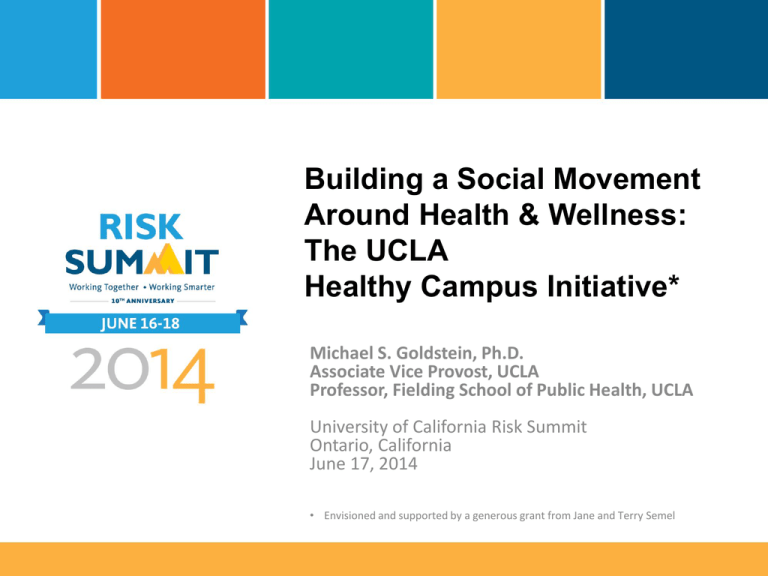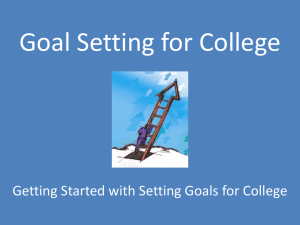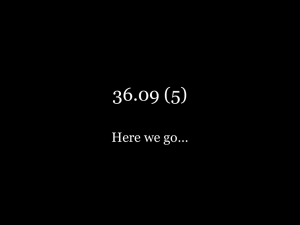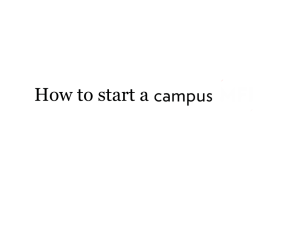
Building a Social Movement
Around Health & Wellness:
The UCLA
Healthy Campus Initiative*
Michael S. Goldstein, Ph.D.
Associate Vice Provost, UCLA
Professor, Fielding School of Public Health, UCLA
University of California Risk Summit
Ontario, California
June 17, 2014
• Envisioned and supported by a generous grant from Jane and Terry Semel
The UCLA Healthy Campus Initiative
• Chancellor Gene Block’s commitment to make UCLA
the healthiest campus in America;
• Jane & Terry Semel share the vision and provide the
means to make the vision a reality.
• What does “health” or being the “healthiest” campus
mean?
– Is health the absence of symptoms and disease?
– World Health Organization: health is “a state of complete
physical, mental and social well-being and not merely the
absence of disease or infirmity”
– Does a group of healthy individuals = a healthy
community/campus?
What is the best way to build a
healthy campus?
• Include existing programs and targeted interventions.
• However, a review of best practices made it clear that while HCI
would include all sorts of targeted interventions, building a
healthy campus would require a different focus:
– Marginal success of targeted interventions
– “Success” is either non-existent or very small, not long lasting nor
clinically significant, especially for vulnerable populations
•
•
•
•
•
•
Davies et.al. 2012 Meta Analysis of Internet Delivered Interventions to Increase Physical Activity
Levels. INTL J BEHAVIORAL NUTRITION AND PHYSICAL ACTIVITY 2012, 9:52.
Kelly et.al. 2013 Systematic Review of Dietary Interventions with College Students: Directions for
Future Research and Practice. J NUTRITION EDUCATION AND BEHAVIOR 2013 45:304-313.
Geaney et. al. The effectiveness of work place dietary modification interventions: A systematic
review. PREVENTIVE MEDICINE 2013 57:438-447.
Rongen, et. al. Workplace health promotion: A meta-analysis of effectiveness. AMER J PREVENTIVE
MED 2013 44:406-415.
Caloyeras et. al. Managing manifest diseases, but not health risks, saved PepsiCo money over seven
years. HEALTH AFFAIRS 2014 33:124-131.
Glasgow et. al. The future of health behavior change research: What is needed to improve
translation of research into health promotion practice? ANNALS OF BEHAVIORAL MEDICINE 2004
27:3-12.
Although targeted programs showed
only limited success, history
demonstrated that major changes on
campus were possible…
• Over the past 50 years we have seen significant changes:
–
–
–
–
–
Civil rights/racial and ethnic diversity
Feminism
Disability rights
LGBT rights
Environmentalism/sustainability
• What each of these changes had in common is that they
grew out of social movements.
• Given these vivid successes, the decision was made to
attempt to build a social movement around health and
wellness on campus.
Characteristics of social movements:
• What?
– Seek changes in norms and values
• Who?
– Large, informal networks of groups or individuals that
focus on bringing about some type of social change
• Why?
– Begins from a sense of injustice about an issue; don’t like
the status quo
• How?
– Come together around a collective discontent about how
some aspect of social life is organized
A health-driven social movement begins
with:
• Understanding that the unhealthy choice
is usually the norm;
• Acknowledging that society has not made
healthy choices easy choices;
• Accepting that these norms reflect the
dominance of certain groups and
interests who benefit from the way things
are.
How does this perspective relate to
“risk”?
• Why do people take risks?
Especially when it increases their chances of
becoming seriously incapacitated or even
dying.
– Because they balance perceived risks and
perceived benefits of an action.
• So, there is little to be gained by focusing on risk
alone.
• Typically there is a conflict between the short-term
benefits of unhealthy behavior and long-term risks of
ill health.
• People don’t take risks (note the individualist bias
in the term) as much as they are presented with
situations/environments that promote and
reward short-term benefits:
– What to eat?
• High fat, sugar, salt, fast foods
– How to deal with stress?
• Watch TV, play video games, etc.
• The Solution?
– Make healthy choices easier
• cheaper, more accessible, more fun
– Make unhealthy choices harder
• more expensive, harder to access, less fun
– Change how healthy behaviors are perceived
• getting a good night’s sleep will lead to better grades, etc.
The health-driven social movement
evolves as the focus shifts from:
CHANGING
the INDIVIDUAL to
CHANGING
the STRUCTURE/CONTEXT
in which the individual exists
Is it realistic for health and wellness to
be core values on campuses today?
• On one hand, institutions of higher education can
be particularly inhospitable to making health a
core value:
– Higher education places value on skepticism and
questioning authority, versus conforming to rules
about how to live one’s life.
– College life presents students with newfound
opportunities to make myriad of choices about life
on a daily basis: what you eat, what substances you
imbibe, who you have sex with, how late you stay
up…
• On the other hand, colleges increasingly recognize that
health and wellness can be:
– A means of “branding” themselves;
– A way (hypothesized) of saving money;
– A major issue for a growing number of campus groups:
• Gender/sexuality
• Ethnic (especially health disparities)
• Sustainability/green/environmental
• Health oriented groups: nutrition, mental health
(meditation etc.), physical exercise, bicycle coalitions
• Thus, for many campuses, including UCLA, the time is ripe
for making health and wellness core values on campus!
From a social movement perspective,
what is a healthy campus?
• It is
– A value-based understanding of health that
resonates with other social movements in
support of ideas that are already important
in university life.
• It is not
– Simply a listing of behaviors, programs or
outcomes, although these are part of a
healthy campus.
What are these basic values?
• High level wellness
– maximizing the potential of individuals
• Personal responsibility
– freedom and autonomy
• Diversity
– social groups define health differently; however they
define it is “right”
• Equity
– strive to reduce health disparities as much as possible
• Integrative
– body, mind and spirit are mutually influencing and
emerge in a communal context
Key Organizing Principle:
BOTTOM UP
• We start where people are:
– Defining health according to their
own ideas, needs and values
– Placing value on shared personal experiences
– In terms of cost/benefits for risk, what do people
really want?
•
•
•
•
•
•
Jobs
Happiness
Fulfillment
versus
Security
Creative outlet
Achievement
Cutting risk of illness or injury
A Healthy Campus movement is…
• Unafraid of conflict:
– Law students want to protest quality of dining commons;
– Faculty want to measure and improve air quality in the workplace;
– Cyclists challenging University relationship with politicians over off
campus bike lanes.
• Supports groups with opposing goals:
– Campus bike group fosters the use of bike helmets;
– Another bike group wants to increase bicycle commuting and
opposes helmet use, which is seen as a deterrent to cycling.
– Student groups favoring caloric labels on all foods;
– Body image support groups opposed to caloric labeling.
• Supports gender and ethnic-specific programs
– LGBT groups with a focus on identity specific goals;
– Groups (e.g. Sex Squad) that focus on common concerns (STDs,
ability to say “no”).
WE SUPPORT THEM ALL!
“TOP DOWN”
approaches are
also important:
• Successful organizations (e.g.
Kaiser Permanente, IBM,
LAUSD) which have made
health and wellness core
values all say that strong
leadership from the top is key
to success.
• But for the most part, the top
is responding to the bottom,
not telling the bottom what to
do.
LEADING BY EXAMPLE
Executive Directives & Actions
MEDIA
• Statements from the Chancellor…
BruinPost, launch, press releases…
DECISION-MAKING
• An independent Steering Committee
with representatives from every
part of campus including students
and staff…
POLICY
• Preamble to planning and
development document…
• 100% Tobacco Free campus…
• Negotiations with beverage
companies for pouring rights…
• Cutting Recreation membership fees
for low salary level workers…
INFRASTRUCTURE
• Building healthier dining halls…
• Bike lanes…
Our logo goes most everywhere…
WE BUILD
–
–
–
–
Alliances
Awareness
Our brand
The movement
In summary, to build a “Healthy
Campus”…
• Acknowledge
– the potential of a social movement to bring about
change;
• Recognize
– that successful leadership will be based in a commitment
to the value of health and wellness, not driven by cost
containment;
• Admit
– that checklists and directed programs are only part of the
answer;
• Accept
– that the change process cannot be controlled completely
from within the administration or by professionals.
QUESTIONS and COMMENTS






